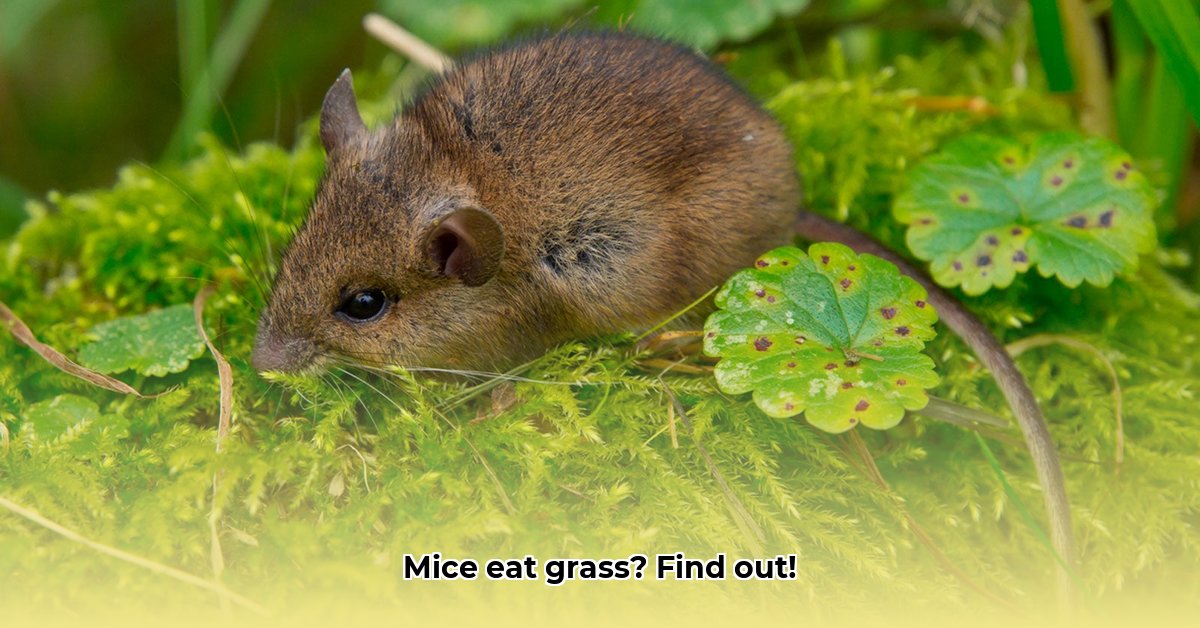Mice are common visitors to our yards, leading many to wonder about their dietary habits. Do they munch on grass? The answer is a bit more nuanced than a simple yes or no. For a comparison of diets in other rodents, see this article on squirrel diets: Squirrel Diets. This article delves into the dietary habits of mice, exploring the role grass plays in their overall menu and providing insights for homeowners, researchers, and farmers alike. We’ll examine different mouse species, seasonal dietary changes, and effective methods for keeping these creatures out of your gardens, helping you understand these adaptable rodents.
Understanding the Mouse Diet: Beyond Grass
While the image of a mouse nibbling on grass might come to mind, it’s essential to understand that grass isn’t their primary food source and might only be a supplement when other options are unavailable. What exactly composes their diet?
A Look at a Mouse’s Preferred Foods
Mice, being omnivores, have a diverse diet consisting of both plant and animal matter. Their go-to choices typically include seeds, grains, and insects. Seeds fallen from plants, crumbs found in pantries, and small insects all make up a mouse’s dinner plate. Grass, however, holds a different place in their dietary preferences.
The Occasional Grass Snack
Mice will consume grass, particularly the tender, young shoots and the seeds found within. This is often the case for field mice who live in open environments with less access to human leftovers. House mice, on the other hand, tend to rely more on readily available human food sources within homes.
Why would a mouse resort to eating grass?
- Fiber: Grass provides essential fiber that aids in a mouse’s digestion.
- Potential Nutrients: Grass might offer some vitamins and minerals. Younger grass shoots, for example, contain chlorophyll, which supports healthy red blood cell production.
- Hydration: Grass can provide moisture intake, especially during drier periods. The dew on grass can be a significant water source.
- Survival: In times of scarce food availability, grass serves as a backup food source.
Unanswered Questions About Mouse-Grass Consumption
Despite our understanding, there are still gaps in our knowledge regarding the extent and reasons behind grass consumption in mice. Further research is necessary to explore factors such as:
- Grass Variety: The nutritional value and appeal of grass to mice vary depending on the species. Some grass types might be more palatable or even toxic. For instance, timothy and orchard grass are often used for livestock feed and are generally safe for mice in small quantities.
- Seasonal Patterns: Studying whether grass consumption changes with the seasons to understand the impact of changing food availability.
- Species Differences: Comparing dietary habits between different mouse species, like house mice and field mice, to account for environmental variations.
- Digestive Efficiency: Investigating how efficiently mice can digest different types of grass and extract nutrients.
- Pesticide Exposure: Understanding if mice eating grass lead to the ingestion of herbicides and pesticides, affecting their health.
Implications for Stakeholders: From Homeowners to Farmers
A mouse’s relationship with grass has diverse implications for homeowners, researchers, and farmers.
| Stakeholder | Impact |
|---|---|
| Homeowners | Keep your home clean, remove food scraps, and seal entry points to effectively deter mice. Use tightly sealed metal containers for storing grass seeds and eliminate hiding spots by mowing the lawn regularly and removing debris. Consider using natural repellents like peppermint oil to deter mice around your property. |
| Researchers | Conduct more studies to understand the nutritional value of grass for mice and its impact on their health. Investigate the role of grass consumption in the spread of diseases and parasites among mouse populations. Explore the potential for using grass-based baits to control mouse populations in agricultural settings. |
| Farmers | Implement effective and humane pest management strategies to minimize crop damage, considering the availability of grass and its influence on behavior. Utilize integrated pest management techniques that focus on habitat modification, biological control, and targeted trapping to reduce reliance on chemical pesticides. Plant cover crops that deter mice, such as certain varieties of clover. |
Although mice may occasionally nibble on grass, it’s not their primary source of food. Seeds, grains, and insects remain the staples of their diet. Ongoing research will continue to deepen our understanding of the dietary habits of these small mammals.
How to Prevent Mice from Eating Grass Seeds in Your Garden
Mice are common garden pests, and while grass isn’t their main target, they do eat grass seeds and damage seedlings. “How to prevent mice from eating grass in my garden” is a valid concern for any gardener. Let’s explore methods to deter these critters.
The Truth About Mice and Grass
The short answer is: sometimes. Mice are omnivores with a diverse diet. They primarily feed on seeds, grains, nuts, and insects. However, when these aren’t available, they’ll munch on young grass shoots and, more importantly, the seeds. They are opportunistic eaters, so if there’s seed accessible, they’ll go for it.
Why Gardens Attract Mice
Gardens are attractive to mice because they provide the two things mice need: food and shelter/cover. Gardens become magnets for mice with seed-rich areas, spilled birdseed, and decaying fruit. They also seek shelter among dense vegetation, debris piles, and cracks in structures.
Key Points to Remember
- Mice are omnivores, and seeds are a primary food source.
- Grass seeds are attractive to mice, especially high-carb varieties.
- Preventing access to food and shelter is key to control.
- Multiple strategies are needed for effective and humane mouse management.
- Mice can breed quickly; addressing the problem early is crucial.
Actionable Steps for Control
- Eliminate Food Sources:
- Clean up spilled birdseed regularly.
- Harvest fruits and vegetables promptly.
- Store pet food in sealed containers. Use metal or thick plastic containers that mice can’t chew through.
- Seal cracks and gaps where mice might enter. Use steel wool or caulk to seal openings larger than 1/4 inch.
- Remove Shelter:
- Keep grass short and clear away debris. Maintain a clear perimeter around your home.
- Trim overhanging branches near your house. This prevents mice from accessing your roof.
- Store firewood away from the house, ideally at least 20 feet, and elevate it off the ground.
- Reduce dense vegetation near your garden. Keep bushes and shrubs trimmed.
- Employ Natural Deterrents:
- Plant peppermint, lavender, or catnip – mice dislike their strong scents. Reapply peppermint oil regularly.
- Scatter crushed eggshells around vulnerable areas; the sharp edges deter them. Replace eggshells after rain.
- Use sonic repellents, which emit high-frequency sounds unpleasant to mice. Be aware that the effectiveness of sonic repellents can vary.
- Sprinkle cayenne pepper or garlic powder around garden beds, but reapply after rain.
- Consider Trapping (Humanely):
- Set humane traps, releasing mice far from your garden (at least a mile away). Check traps daily.
- Use peanut butter or oatmeal as bait.
- Avoid toxic poison, as it poses risks to other animals and the environment. Poisons can also contaminate the food chain.
- Consider using snap traps as a last resort, placing them in areas inaccessible to pets and children.
- Introduce Predators (Naturally):
- Encourage natural predators like owls, cats, and snakes around your property.
- Provide owl nesting boxes and safe habitats for feral cats.
Protecting Newly Planted Grass
New grass seed is particularly vulnerable. Efforts to “how to prevent mice from eating grass in my garden” intensify. Here are tips:
- Protect Seedlings: Cover newly sown seeds with netting or a fine mesh screen to deter gnawing.
- Repellents: Use commercial rodent repellents designed for seed protection, following label instructions carefully. Choose repellents that contain ingredients like capsaicin.
- Deep Planting: Plant seeds slightly deeper than usual to make them less accessible. Follow recommended planting depths for your grass type.
- Water Management: Water newly planted seeds lightly and frequently to encourage rapid germination, reducing the window of opportunity for mice.
- Companion Planting: Consider planting marigolds or other plants known to deter rodents near your new grass.
Impact of Grass Type on Mouse Digestion and Overall Health
Mice are omnivores, and their diets vary depending on the species, season, and available food sources. While grass isn’t their primary food, they will consume it, especially when other food is scarce. The nutritional and digestible value of grass significantly impacts a mouse’s health.
Decoding the Mouse Menu
Mice are opportunistic eaters, and their menus depend on what’s readily available. Seeds, grains, and insects are usually the top choice, but grass often plays a supporting role. This means a mouse’s diet might change dramatically depending on the season and environment. House mice, for example, may focus on human food scraps indoors, while field mice eat more seeds outdoors.
The Role
- Gluten Free Meal Prep Ideas for Delicious, Hassle-Free Eating - November 28, 2025
- Gluten Free Meal Prep for Stress-Free and Healthy Eating - November 27, 2025
- Quick And Easy Chicken Thigh Meal Prep For Weight Loss - November 26, 2025










